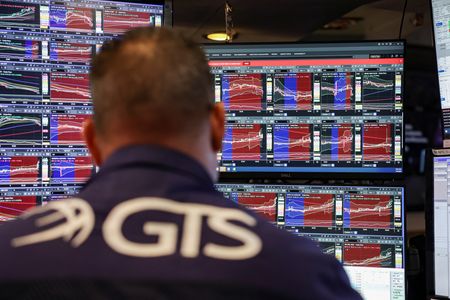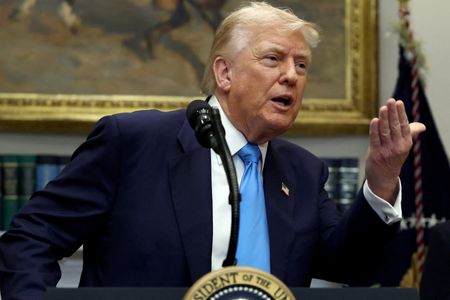By Naomi Rovnick
LONDON (Reuters) -Investors’ conviction that U.S. President Donald Trump’s tariffs and debt spree would spark long-term pain for the dollar and U.S. stocks is crumbling, signaling pain ahead for assets across Europe and emerging markets that were boosted by this view.
The dollar, which suffered its worst first-half performance since 1973 this year, is now barreling towards its first monthly gain of 2025 after the Federal Reserve resisted a rate cut, U.S. growth data was unexpectedly robust and trade war fears eased.
That puts the so-called “rest of the world” trade, predicated on the idea of a crisis of confidence in U.S. assets but according to Barclays analysis mostly driven by investors’ desire to cut exposure to a weakening dollar, at risk, investors said.
On Thursday, futures trading suggested Wall Street stocks were set for a more than 1% daily gain that could end this year’s burst of European equity outperformance, while the euro and Asian and emerging market assets fell sharply.
“It’s one of the biggest positions people have, being negative on the dollar and the U.S.,” Pictet Asset Management co-head of multi-asset Shaniel Ramjee said.
He was preparing to raise his dollar exposure from what he described as “practically zero”, on expectations that U.S. economic trends would start outshining Europe.
A broad dollar revival, he added, might bring 2025’s big market trends to a halt.
And as U.S. rate cut expectations faded on Thursday, some investors said the Fed may support the idea of a dollar recovery to reduce the effect of higher import costs, driven by tariffs, on consumer price inflation.
COMEBACK
European stocks, which posted their best-ever quarter relative to the U.S. in the three months to March, are now clocking an 8.4% year-to-date gain against the U.S. S&P 500’s 8.1 rise ahead of Thursday’s market open.
As recently as mid-July, conviction that the dollar would weaken was the most crowded trade among global fund managers, Bank of America research showed.
That big anti-dollar bet, valued at $18 billion and by far the biggest wager in foreign exchange markets, has run into trouble after the euro, which rose to $1.1789 this month, hit 1.1401 after Wednesday’s Fed meeting.
The common currency, which scored the best six-month run of its 26-year lifetime in first half of the year, is now heading for its largest monthly drop against the dollar since May 2023..
On Thursday, a gauge of emerging Asian equities slipped more than 1% to a two-week low and MSCI’s broad emerging market currency index headed for its first monthly loss this year.
Britain’s pound, meanwhile, was set for a 1.6% weekly loss, in what would be its worst performance on this metric since January’s UK market rout.
“We’re seeing a rotation into U.S. equities, a rotation in currency markets and a rotation in (market) momentum,” Edmond de Rothschild Asset Management multi-asset head Michael Nizard said.
He cited Sunday’s framework trade deal between Washington and Brussels as a major reason for the trend, which he did not expect to last until the end of the year, adding that he would buy the euro at around $1.14.
But River Global portfolio manager Bettina Edmondston said a stronger dollar would help tame U.S. inflation, meaning a new so-called Fed put, where the central bank prop ups falling markets with monetary policy, may have opened up for the greenback.
“I don’t expect interest rates to come down, which intuitively makes you think the dollar should be stronger,” she said.
TEMPORARY?
Monica Defend, head of the investment institute at Europe’s largest asset manager Amundi, said she was sticking to a long-term view that the dollar was set to decline because of Trump’s borrowing plans and consistent attacks on Federal Reserve independence.
But she said she was also prepared to change her view “if growth in the U.S. surprises nicely on the upside,” in a persistent trend from here.
“The U.S. might continue to be exceptional, probably not on the macro (economic) front, but more on the equity market,” she said.
Nutshell Asset Management CIO Mark Ellis said he was not certain the U.S. dollar and Wall Street stocks would keep rising in tandem in August, typically one of the worst months of the year for market volatility.
“Around the end of this week is a good time to take risk off and I’ll be more defensive going into historical summer volatility and weakness,” he said.
Barclays head of European equity strategy Emmanuel Cau, in a July 30 note to clients, issued a different warning.
He noted that trend-following hedge funds called CTAs, whose trades are viewed as a barometer of the dominant market mood, had closed out bets against U.S. Treasuries and cut exposure to European stocks.
A more persistent dollar bounce-back, he said, would be “a key pain trade” for global investors from here.
(Reporting by Naomi Rovnick; Editing by Amanda Cooper and Philippa Fletcher)











